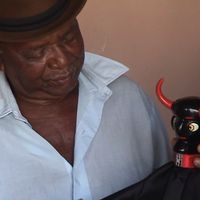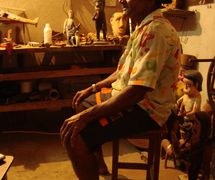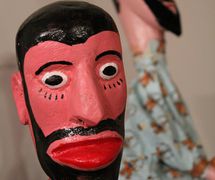Form of popular Brazilian puppet theatre, which was developed in the region of Nordeste (Northeast), mainly in the state of Pernambuco. Although the name “Mamulengo” is taken as a reference to the puppet theatre in the Northeast in general, it is important to note that it concerns mainly the state of Pernambuco. In other northeastern states, the puppet theatre is known by the names of characters: João Redondo and Calunga (in Rio Grande do Norte); Babau (in Paraíba and Pernambuco); Casemiro Coco (in Ceará and Maranhão). It is also important to note that they are not isolated traditions. They share mutual influences.
Diverse hypotheses have been put forth regarding its origins. According to one hypothesis, the mamulengo would have surged under the influence of presépios de fala (talking crèches; see Nativity Scenes) with string puppets or rod puppets, or even casas de farinha (flour houses), a kind of show worked either mechanically or manually. But one could also say that mamulengo derives from pastorais (pastorals), popular shows presented with actors, and then with wooden puppets. The etymology of the word is obscure. According to some researchers the word mamu could be a diminutive form of Manuel, the first name of a puppeteer, better known as Mané (diminutive of Manuel) Gostoso, while the ending lengo could have a link to the expression lenga-lenga (incessant to and fro movement) or even with the expression mão molenga (indolent hand).
A Profoundly Popular Theatre
As is the case in every kind of popular theatre, the characters of mamulengo represent well-defined social types from all social classes, from the most humble (almost always represented by black puppets) right up to the proprietor, while also representing those like the doctor, the dentist or the police officer. Amongst the most well-known characters that appear are, on the one hand, Benedito the Negro, very modest yet at the same time very cunning, and, on the other hand, the captain João Redondo, boss and arrogant country squire, representing political power. These two figures could appear under other names like Nego Tião, Professor Tiridá, Cabo 70 or Simão. On the other hand, Quitéria is the name most often given to the female character. One can see the resemblance between these emblematic characters and those of European puppet theatres, like Pulcinella, Polichinelle, Punch, Kasperl or Guignol, in the fact that they perform a similar function, one of satire or even subversion.
The mamulengo theatre incorporates some mythological figures, even medieval elements and abstract ideas like the Devil, vampires, Death, and the Soul of the Dead. Animals also have a symbolic role: the serpent (or the caiman) incarnates an evil spirit and is always linked to the idea of original sin, whereas the bull is the symbol of both hope and of oppression.
The shows contain numerous fight sequences, ending almost always “in blood”. Once puppets have killed one another, two more puppets arrive on stage with a net to pick up the bodies. The music is an integral part of the shows, and it is to the beat of the baião, forró or of the xaxado (musical styles of Northeastern Brazil) with accordion, drum and triangle, that the scenes unfold, alternating with animated action behind the booth (see also Puppet Stages), all orchestrated by the mamulengueiro (mamulengo player) or the mestre (master). Some of the most famous mamulengueiros are Babau (Severino Alves Dias), Zé da Viña (José Severino dos Santos), Mestre Luis da Serra (Luiz José dos Santos), Ginu, Cheiroso, and Mestre Solon.
But the mamulengueiro is not a simple presenter or actor; in fact he thinks in a quasi-mystical manner, being possessed by the soul of the animated creatures. A show can last from two to eight continuous hours, and since it is based largely on improvisation, it requires intense participation from the public. Some members of the audience have a conversation with the puppets and even offer them food. In the farms and villages, a mamulengo show is a highly awaited event, and the close complicity between puppets and public explains the fact of surveillance by the authorities, because behind the laughter slides in criticism and revolt.
The mamulengo puppets are quite primitive and, for the most part, are made of mulungu wood by the puppeteers themselves. Mamulengo consists of glove puppets animated by three fingers, namely the thumb and the little finger for the arms and the index finger for the head, and rod marionettes with varied controls: one with the rod fixed between the legs, another with a rod attached to the back with one to each of the feet to animate them. More rigid figures, like policemen and soldiers, can be suspended by a rod fixed on to one of the legs. More sophisticated ones, personalities like Simão, have articulated mouths, tongues and even eyes – they can stick out their tongue and can blink. The show takes place in the open, where the stage is generally about 2 metres high, 1.50 metres deep, often decorated with bright colours.
In the meanwhile, this corresponds to a reality, which is less harsh. In the beginning of the 21st century the public that came to watch a mamulengo show became increasingly scanty. This popular art bore the full brunt of changes in society and began to disappear from town squares, fairs and festivals of the North and the Northeast. Attempts to introduce mamulengo in urban centres led to poor results, and one could say that without certain initiatives for the preservation of this art form, its existence would be in danger. As Álvaro Apocalypse underlines the fact, the danger lying in wait for mamulengo, as for all popular art, is “to become fossilized or crystallized in its traditional form, and to remain fixed and unchanging, and to submit to all the changes in the values of the social system from which it arose”. Looking at it from a dramatic perspective, “if one admits that its oral nature and improvised form have become crystallized, then the mamulengo art form can contribute only marginally to deepening knowledge regarding artistic creations. It can, all the same, serve to inspire newer art performances”.
Nonetheless, mamulengo is still alive and remains the richest form of popular puppet theatre in Brazil.
(See Brazil.)
Bibliography
- Alcure, Adriana Schneider. A Zona da Mata é rica de cana e brincadeira: uma etnografia do Mamulengo [The Zona da Mata is Rich in Sugarcane and Jokes/Fun and Games: An Ethnography of Mamulengo]. Tese de Doutorado [Doctoral Thesis]. Universidade Federal do Rio de Janeiro, 2007.
- Borba Filho, Hermilo. Fisionomia e espirito do mamulengo [Appearance and Spirit of Mamulengo]. Rio de Janeiro: INACEN, 1987.
- Brochado, Izabela Costa. “Distrito Federal: o mamulengo que mora nas cidades 1990-2001” [Federal District: Mamulengo Living in Cities 1990-2001]. Dissertação de Mestrado em História. Programa de Pós-Graduação em História. Instituto de Ciências Humanas. Universidade de Brasília, 2001.
- Brochado, Izabela Costa. “Mamulengo Puppet Theatre in the Socio-Cultural Context of Twentieth-Century Brazil”. PhD Thesis. Samuel Beckett School of Drama, Trinity College Dublin 2005.
- Cossu, Giorgio, photographer with Celina Dávilla, interviewer. Mamulengo: Teatro popolare di burratini in Brassile [Mamulengo: Popular Puppet Theatre in Brazil]. Pisa: Totivilus Editions, 2008. (In Italian, includes a DVD.)
- Lima, Marcondes. A arte do brincante no mamulengo e no bumba-meu-boi [The Art of the Brincante (Players) in Mamulengo and Bumba-meu-boi]. Dissertação (Mestrado em Teatro). Universidade Federal da Bahia, 2003.
- Mikol, Bruno, Magda Modesto, and Fernando Augusto Gonçalves Santos. Marionnettes en Territoire Brésilien [Puppets in Brazilian Territory]. Charleville-Mézières: Institut International de la Marionnette, 1994.
- Pimentel, Altimar de Alencar. O Mundo Mágico de Joáo Redondo [The Magical World of João Redondo]. Rio de Janeiro: Ministério da Cultura: Fundação National de Artes Cénicas, 1988.
- Santos, Fernando Augusto Gonçalves. Mamulengo: um povo em forma de bonecos [Mamulengo: A People in the Form of Puppets]. Rio de Janeiro: FUNARTE, 1979.
- Silva, H. Pereira da. “Teatro de Bonecos” [Puppet Theatre]. Revista de Teatro. No. 462, 1987, pp. 11-12.
- Simões, Francisco de Oliveira Neto. A Tradição do Mamulengo. Relatório de Pesquisa apresentado ao Minc do Brasil [A Tradition of Mamulengo. Research Report presented to (Ministério da Cultura) MinC do Brasil]. Bolsa Virtuose. Brasília, 2001.
- Simões, Chico, and Alipio Carvalho Neto. “Mamulengo”. Puck. No. 12. Charleville-Mézières: Éditions de l’Institut international de la marionnette, 1999.
Simões, Chico, and Alipio Carvalho Neto. “Mamulengo: O Teatro de Bonecos no Nordeste Brasileiro” [Mamulengo: The Puppet Theatre in Northeast Brazil]. Adagio. No. 20, 1999, pp. 1-5. - Souza, J. Galante de. O Teatro no Brasil [Theatre in Brazil]. Vol. 1. Rio de Janeiro: Ministério da Educação e Cultura/INL, 1960.














